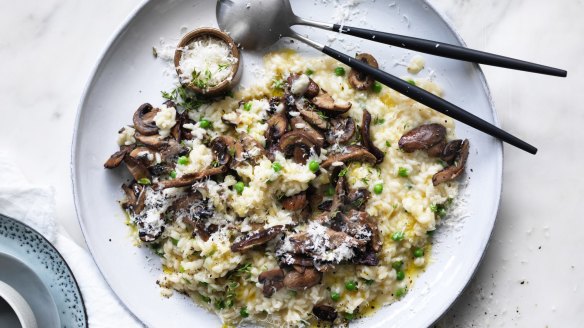The secrets and myths behind a perfect bowl of risotto

Why do people use wooden spoons with a hole in it when making risotto? R. Bryant.
Risotto is one of those dishes that is surrounded by much myth and fable, like an anti-vax website. I have made a lot of risotto and read a lot about it. Risotto is a creamy dish that, while viscous like fresh cement, has a luscious mouthfeel with a clean finish. Firstly, you must make sure the rice is right. Arborio is common but carnaroli rice is better. It has the right ratio of the two different starches. On the inside of the grain is amylose. This absorbs the stock and becomes soft and full of the flavour of the stock and wine. On the outside is another starch, amylopectin. This swells and gelatinises just like flour does in a sauce. The funny thing is that amylopectin doesn't like high heat and won't gelatinise as much if it has been heated too high for too long. This means being careful when you're toasting the rice in the oil and/or butter at the start. Almost all recipes call for a straight-sided pot. But this means the rice on the bottom will cook more if the rice is not stirred during cooking. Finally "mounting" (finishing) the risotto by adding plenty of good quality, cold butter and grated parmesan enhances the creaminess of the dish. I have read reports that a wooden spoon with a hole in it helps create a vortex when making creamy, thickened sauces, but these tend to be found on the websites that are selling them. I have spoken to a good number of Italian chefs and they all just use a normal wooden spoon to make their risotto. Go figure.
Letters
Last week we were discussing why some carrots are called Dutch. This stirred a response from reader J. McCurdy-Hilbrink. "I retrieved my curly kale out of the freezer before starting on a 'boerenkool stamppot'. It's a simple dish beloved by the Dutch, a people not known for the subtlety of their cuisine. For the Dutch, 'boerenkool' (kale) is eminently a winter vegetable which gets boiled together with potatoes and onions, then vigorously mashed (the term 'stamppot' should give you some idea – as should the term 'hutspot' (English 'hotchpotch') for a similar dish with carrots). A knob of butter is added, and the dish is served up with smoked sausage which has been simmering on top of the potatoes and kale. So now back to the freezer: it was found that when this vegetable was taken from the ground after a night's frost, it tasted wonderfully sweet. I incidentally found that frozen kale is very easy to prepare for the stamppot recipe, which requires the leaves to be finely shredded. One only needs to 'saw' through the frozen head of the kale or just rub the leaves off the stems." I think there is something in that for everyone.
Send your vexing culinary conundrums to brainfood@richardcornish.com.au or tweet to @realbrainfood.
Appears in these collections
- More:
- Food
- Brain food
